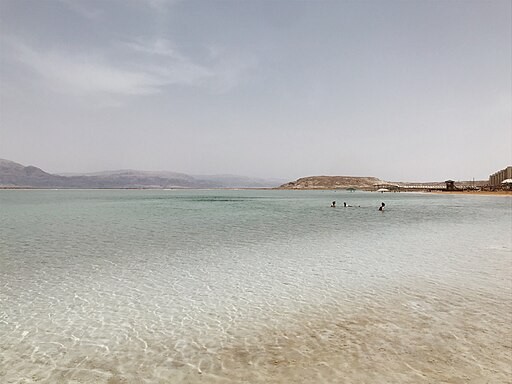The Dead Sea is considered to be the second saltiest body of water on Earth, topped in brininess by Gaet'ale Pond in Danakil Depression, Ethiopia. Despite its name, the Dead Sea is actually a land-locked lake, rather than a sea, located between Israel, Jordan, and Palestine.

(Photo : Wikimedia Commons/ Chloekwak)
This body of water is called "dead" since no fish, plants, or birds can survive in its high-saline environment. Along the shores, sat buildup collects in rocky ridges, peaks and towers. Tourists also find that the extra-salty water in this lake is so buoyant that they can practically sit on its surface.
How Salty is the Dead Sea?
According to the National Oceanographic and Atmospheric Administration (NOAA), most ocean water is usually about 3.5% dissolved salts. If all of the salt in the ocean were removed and spread over all of the dry land on Earth, the layer would reach a height of 500 feet (150 meters). Still, all of that salt is just a drop in the bucket compared to the amount of salt in the Dead Sea's waters.
NOAA estimates that the water in the Dead Sea is five to ten times as briny as normal seawater. Salinity increases in the deeper waters of the sea. At depths below 300 feet (100 meters), the water gets so concentrated with salt that it can hold no more, and the salt builds up on the seafloor. According to the NASA Earth Observatory, the extreme salinity in the Dead Sea gives the feeling of olive oil mixed with sand. This means that anybody can float on it with ease.
READ ALSO: Dead Sea Drought Surprised Researchers' Previous Beliefs
Why Is the Dead Sea Salty?
According to NOAA, the salt in normal seawater originates in rocks on land. As acids in rainwater dissolve the rocks and create charged atomic particles, the runoff is carried into the ocean. The most common of these ions are sodium and chlorine, which accumulate in the ocean as salt.
The Dead Sea is located in a fault valley which covers over 620 miles (1,000 kilometers), starting from the tip of the Sinai Peninsula and extending northward to Turkey. Its elevation is also the lowest on the planet, about 1,407 feet (429 meters) below sea level. According to the Minerva Dead Sea Research Center (MDSRC), this valley was once occupied by a series of lakes, but the last of them disappeared 15,000 years ago, leaving only the Dead Sea behind. In addition, the region's heat and mineral-rich springs sprout along the Dead Sea shores due to tectonic activity.
The Jordan River serves as a source of freshwater which feeds the Dead Sea. But since there is no outlet, the freshwater has nowhere else to go when it reaches the sea. In the arid low-lying desert, the water that collects in the Dead Sea evaporates more quickly than water in the open ocean. As a result, vast quantities of salt are left behind.
The saltiness of the Dead Sea is even made more intense by human activity as less water reaches it from the Jordan River. Such activities include dams and diversion for agriculture. As humans either redirect or prevent the flow of water, less fresh water reaches the Dead Sea. This results in having less available water to dilute the salty lake. Moreover, the water in the Dead Sea has also been found to be dropping at a rate of about 3.9 feet (1.2 meters) per year as a result of human activities.
RELATED ARTICLE: What Ancient Science Secret Was This Dead Sea Scroll Hiding?
Check out more news and information on Dead Sea in Science Times.














